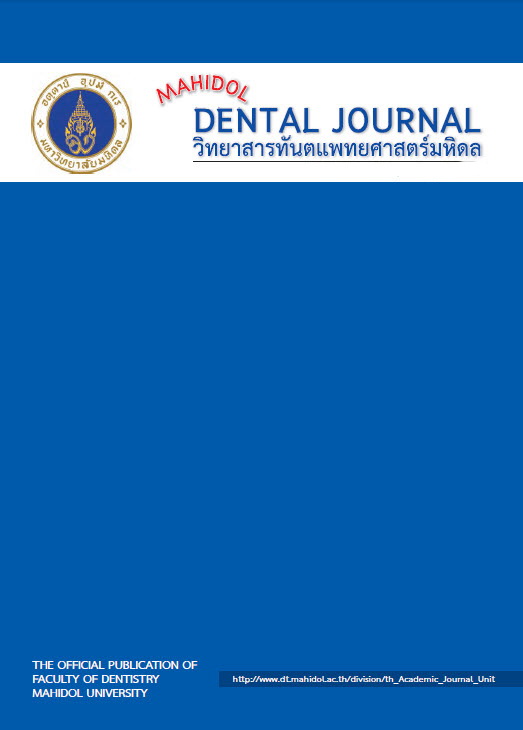Marginal and internal gaps of crown and bridge substructure of two all-ceramic systems
Main Article Content
Abstract
Objective: The objectives of this study were to compare the marginal and internal gaps of two ceramic systems
as well as the marginal and internal gaps between single crowns and three-unit fixed dental prostheses (FDPs)
substructures.
Materials and Methods: Ceramic substructures were fabricated using CAD/CAM (Lava™ Zirconia) and heatpress technique (IPS e.max® Press) as premolar and molar single crowns and three-unit FDPs (4 groups, n=10).
Marginal and internal gap widths were determined and measured using silicone replica technique. Results were
analyzed using Mann Whitney U-test (α= 0.05), and data were described as median and interquartile range.
Results: For IPS e.max® Press, there was no significant difference of marginal adaptation between the crown
and bridge groups, except at the mesial marginal gap of premolar (Crown; 39 μm, Bridge; 106 μm). For Lava™
Zirconia, differences were found at several locations of the premolar and one point of the molar. Significant
differences of marginal gap between IPS e.max® Press and Lava™ Zirconia crown substructures were found
only in premolar. There were also significant differences of marginal fit of FDPs between two systems in both
abutments. Significant differences of internal fit were mostly found in the axial wall and the cusp tip areas.
Conclusions: Most marginal and internal gaps of IPS emax® Press were greater than those of Lava™ Zirconia
except at the occlusal locations. In addition, three-unit FDPs revealed larger gap widths than those of single
crowns in both ceramic groups.
Article Details
References
2. Gökçen-Röhlig B, Saruhanoglu A, Cifter ED, Evlioglu G. Applicability of zirconia dental prostheses for metal allergy patients. Int J Prosthodont 2010;23:562-5.
3. Conrad HJ, Seong WJ, Pesun IJ. Current ceramic materials and systems with clinical recommendations: a systematic review. J Prosthet Dent 2007;98:389-404.
4. Abduo J, Lyons K, Swain M. Fit of zirconia fixed partial denture: a systematic review. J Oral Rehabil 2010;37:866-76.
5. Colpani JT, Borba M, Della Bona A. Evaluation of marginal and internal fit of ceramic crown copings. Dent Mater 2013;29:174-80.
6. Martins LM, Lorenzoni FC, Melo AO, et al. Internal fit of two all-ceramic systems and metal-ceramic crowns. J Appl Oral Sci 2012;20:235-40.
7. Tuntiprawon M, Wilson PR. The effect of cement thickness on the fracture strength of all-ceramic crowns. Aust Dent J 1995;40:17-21.
8. Adel F. Ibraheem, Sattar J.A. Hmedat. A comparison of vertical marginal fit of three different types of all ceramic crown restorations (An In vitro study). J. Genet. Environ. Resour. Conserv. 2015;3:84-92.
9. Asavapanumas C, Leevailoj C. The influence of finish line curvature on the marginal gap width of ceramic copings. J Prosthet Dent 2013;109:227-33.
10. Ural C, Burgaz Y, Sarac D. In vitro evaluation of marginal adaptation in five ceramic restoration fabricating techniques. Quintessence Int 2010;41:585-90.
11. Beuer F, Neumeier P, Naumann M. Marginal fit of 14-unit zirconia fixed dental prosthesis retainers. J Oral Rehabil 2009;36:2.
12. Kunii J, Hotta Y, Tamaki Y, et al. Effect of sintering on the marginal and internal fit of CAD/CAM-fabricated zirconia frameworks. Dent Mater J 2007;26:820-6.
13. Reich S, Kappe K, Teschner H, Schmitt J. Clinical fit of four- unit zirconia posterior fixed dental prostheses. Eur J Oral Sci 2008;116:579-84.
14. Holmes JR, Bayne SC, Holland GA, Sulik WD. Considerations in measurement of marginal fit. J Prosthet Dent 1989;62:405-8.
15. Yüksel Ece, Zaimoğlu Ali. Influence of marginal fit and cement types on microleakage of all-ceramic crown systems. Braz Oral Res 2011;25:261-6.
16. Richardson DW, Fletcher VA, Gardner LK, Allen JD. Film thickness of die coating agents. J Prosthet Dent 1991;66:431-4.
17. Ivoclar North America. IPS Empress All-Ceramic Crown Laboratory Manual. Amhert, New York: Ivoclar North America; 1992.
18. Dong JK, Luthy H, Wohlwend A, Schärer P. Heat-pressed ceramics: technology and strength. Int J Prosthodont 1992;5:9-16.
19. Bornemann G, Lemelson S, Luthardt R. Innovative method for the analysis of the internal 3D fitting accuracy of Cerec-3 crowns. Int J Comput Dent 2002;5:177-82.
20. Pfeiffer J. Dental CAD/CAM technologies: the optical impression (II). int J Comput Dent 1999;2:65-72.
21. Luthardt R, Weber A, Rudolph H, et al. Design and production of dental prosthetic restorations: basic research on dental CAD/CAM technology. Int J Comput Dent 2002;5:165-76.
22. Beuer F, Naumann M, Gernet W, Sorensen JA. Precision of fit: zirconia three-unit fixed dental prostheses. Clin Oral Investig 2009;13:343-9.
23. McLean JW, von Fraunhofer JA. The estimation of cement film thickness by an in vivo technique. Br Dent J 1971;131:107-11.
24. Ishikiriama A, Oliveira Jde F, Vieira DF, Mondelli J. Influence of some factors on the fit of cemented crowns. J Prosthet Dent 1981;45:400-4.
25. Nawafleh NA, Mack F, Evans J, Mackay J, Hatamleh MM. Accuracy and reliability of methods to measure marginal adaptation of crowns and FDPs: a literature review. J Prosthodont 2013;22:419-28.
26. Schmalz G, Federlin M, Reich E. Effect of dimension of luting space and luting composite on marginal adaptation of a class II ceramic inlay. J Prosthet Dent 1995;73:392-9.
27. Mitchell CA, Pintado MR, Douglas WH. Nondestructive, in vitro quantification of crown margins. J Prosthet Dent 2001;85:575-84.
28. Shearer B, Gough MB, Setchell DJ. Influence of marginal configuration and porcelain addition on the fit of In-Ceram crowns. Biomaterials 1996;17:1891-5.
29. Rahme HY, Tehini GE, Adib SM, Ardo AS, Rifai KT. In vitro evaluation of "replica technique" in the measurement of the fit of Procera crowns. J Contemp Dent Pract 2008;9:25-32.
30. Laurent M, Scheer P, Dejou J, Laborde G. Clinical evaluation of the marginal fit of cast crowns – validation of the silicone replica method. J Oral Rehabil 2008;35:116-22.


